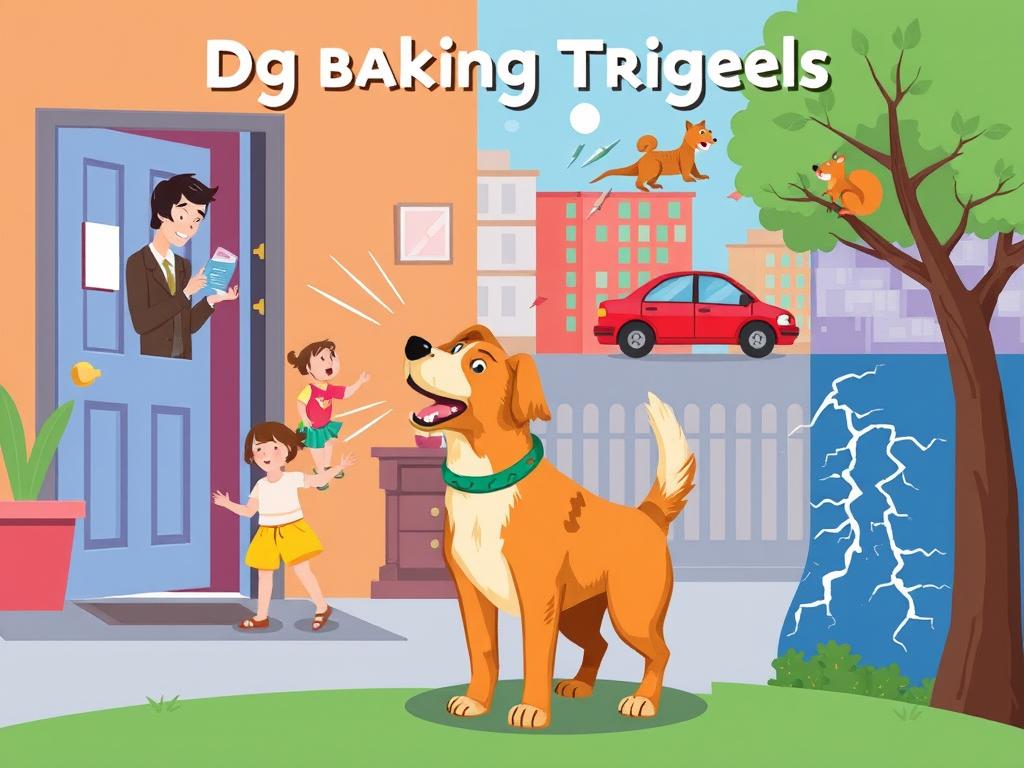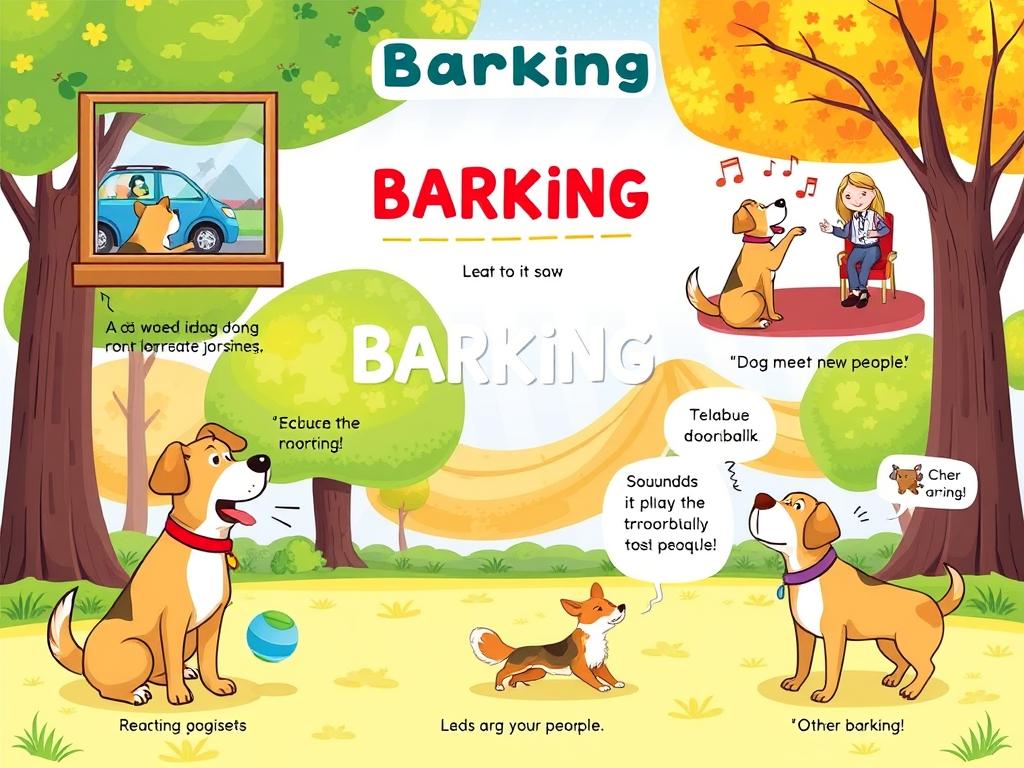Did you know that nearly 80% of dogs exhibit signs of stress when left alone, often manifesting through excessive barking? Understanding why your dog barks all the time is crucial for both their well-being and maintaining peace in your home. Barking is a natural form of communication, allowing dogs to express emotions such as excitement, fear, or frustration. However, a marked increase in this behavior can signal underlying issues like health problems, boredom, or environmental changes. Identifying and addressing the dog barking causes is essential for curbing excessive dog barking and improving your dog’s emotional health.
In the journey to understand dog behavior problems, it’s important to recognize that every bark serves a purpose. By exploring the myriad reasons behind barking—from attention-seeking antics to responses to territorial threats—you can begin to foster a better communicative relationship with your furry friend. Implementing proven solutions and possibly seeking professional help can genuinely transform your dog’s barking behavior.
Key Takeaways
- Understanding why dogs bark is vital for emotional health.
- Different barking types reflect diverse dog emotions and situations.
- Excessive barking often indicates deeper issues like anxiety or boredom.
- Identifying triggers can help manage and reduce unnecessary barking.
- Establishing routines and consistent training are crucial for a harmonious environment.
Understanding Your Dog’s Barking Behavior
Recognizing your dog’s barking behavior is crucial for addressing dog behavior problems. Barking serves various purposes, ranging from alerting to danger to expressing needs. Understanding the significance of barking and its various forms aids pet owners in responding appropriately.
The Importance of Barking for Dogs
Barking is a natural form of canine communication that plays an essential role in how dogs interact with their environment. Dogs bark for numerous reasons, including attention-seeking, excitement, fear, and anxiety. Such situations create barking triggers unique to each dog. Observing how a dog communicates through barking allows owners to better comprehend their pet’s state of mind.
Different Types of Barks
Each bark is distinct, conveying different emotions. For example:
- Demand Barking: Short and controlled barks that indicate urgency, typically requesting attention or specific items.
- Alarm Barking: Triggered by external stimuli, alerting owners to perceived threats.
- Anxious Yapping: A sign of distress, commonly evident in new or loud environments.
Understanding these nuances is vital for dog barking solutions, allowing you to implement targeted strategies to manage your pet’s behavior effectively.
Dogs Communicating Emotionally
Dogs express a range of emotions through barking, which can serve as a signal for their current feelings. Observing your dog’s body language alongside their barking provides insights into their emotional state. Recognizing these markers is important when addressing specific dog behavior problems, as every bark communicates something unique.
Ultimately, understanding why dogs bark is key to improving communication and establishing a harmonious relationship with your furry friend. Identifying the underlying reasons, such as anxiety or excitement, can guide appropriate interventions and behavioral training.
For more in-depth strategies to address barking issues, you can explore this comprehensive guide on dog behavior problems.
Common Causes of Excessive Barking
Understanding why a dog barks excessively is essential for addressing the core issues at play. Several factors contribute to this behavior, each requiring different approaches to remedy the situation. By recognizing these causes, pet owners can implement effective dog barking remedies that not only reduce barking but also enhance their dog’s overall happiness.
Boredom and Lack of Exercise
Many dogs bark out of boredom or frustration. When a dog has insufficient mental and physical stimulation, it may resort to barking as a way to express its needs. Regular exercise is crucial; a daily routine that includes walks and playtime helps keep dogs engaged and less likely to exhibit unwanted vocalizations. Implementing dog training tips like interactive toys can also keep them entertained.
Territorial Behavior
Dogs are naturally territorial animals. They often bark to alert their owners of perceived threats or intruders. This type of barking, known as alarm barking, can be addressed through training to distinguish between real threats and normal occurrences. The goal here is to stop dog barking linked to territorial instincts, allowing for a more peaceful environment.
Anxiety and Stress Factors
Separation anxiety significantly impacts a dog’s behavior. Dogs left alone for extended periods may bark excessively due to fear and loneliness. Understanding this emotional distress is a critical step in finding appropriate interventions. Strategies such as creating a safe space in the home, using calming aids, and gradual desensitization can alleviate these feelings. For more information on managing separation anxiety and enhancing your dog’s well-being, consider exploring helpful techniques here.

Identifying Triggers for Your Dog’s Barking
Understanding what prompts your dog to bark can significantly aid in managing excessive dog barking. Identifying the specific barking triggers allows owners to take appropriate actions. Various factors contribute to this behavior, highlighting the need for careful observation. Below are some common triggers.
Situational Triggers
Situations often provoke barking. For instance, the arrival of guests or any unexpected visitors may cause a dog to react defensively. Alarm barking may signify perceived dangers, such as unfamiliar people approaching the home. A dog feeling threatened or territorial due to an invasion of personal space responds with vocalizations. Recognizing these dog barking causes helps in determining the right approach to training. Conducting guest trials can prepare your dog for different interactions.
Environmental Influences
Environmental conditions also influence barking behavior. Loud noises, like thunder or fireworks, can evoke anxiety in dogs, triggering fear-based barking. Changes in an owner’s routine, such as long absences, may lead to separation anxiety. Boredom is another contributing factor; without adequate stimulation, particularly in high-energy breeds, a dog may resort to incessant barking. Observing surroundings allows owners to pinpoint barking triggers and make necessary adjustments to the environment.
The Role of Socialization
Socialization greatly impacts a dog’s response to various stimuli. Dogs that lack social exposure may bark excessively at unfamiliar situations, expressing discomfort or fear. Engaging in regular interactions with other dogs and humans enhances their comfort level, reducing anxiety and excessive barking. Promoting positive experiences through consistent socialization practices fosters confidence. For more details on improving your dog’s behavior when guests arrive, visit this guide on training your dog to behave around.

Effective Solutions to Curb Excessive Barking
Addressing excessive barking requires a thoughtful approach focused on understanding the underlying motivations. Implementing effective strategies can significantly decrease the frequency of barking in your dog. Here are some practical dog training tips and solutions for common barking dilemmas.
Training Techniques and Commands
Quiet dog training is an essential technique in managing excessive barking. Teaching your dog commands such as “quiet” can establish clear expectations for behavior. Dog trainers recommend using positive reinforcement when the dog remains quiet on cue. Repeated practice allows the dog to associate silence with rewards. Involving fun training methods, like utilizing toys, also enhances engagement and fosters a positive learning environment.
Providing Mental and Physical Stimulation
Regular physical activity plays a crucial role in mitigating barking. Statistics suggest that 60% of dogs show improved behavior with adequate exercise. Integrating mental stimulation through puzzles and interactive toys keeps dogs engaged and prevents boredom. Daily walks and play sessions not only help reduce barking but also strengthen the bond between you and your dog. Addressing stimulation directly tackles the boredom and frustration that often leads to excessive barking.

Creating a Calm Environment
Establishing a calm atmosphere at home contributes significantly to reducing excessive barking. A consistent routine helps dogs feel secure and anticipate their needs. Providing a comfortable space with soft bedding and noise-masking options, such as music or a television, can aid in easing anxiety. When dogs feel relaxed, they are less likely to bark at every noise or stimuli that trigger their attention. Understanding your dog’s unique triggers aids in creating optimal surroundings that discourage barking.
Seeking Professional Help When Needed
When self-management strategies fall short, seeking professional help becomes essential for addressing persistent dog behavior problems. Professional guidance can illuminate underlying issues and provide tailored solutions for specific barking challenges. Here are key points to consider when looking for assistance.
When to Consult a Veterinarian
A visit to the veterinarian is necessary when excessive barking may stem from medical issues. Common health problems can contribute to barking behaviors, including pain, discomfort, or neurological conditions. Ruling out such causes is vital before implementing behavioral techniques or treatments.
Finding a Certified Dog Trainer
A certified dog trainer can provide a structured approach to manage barking. Trainers create customized training programs that address various motivations behind barking, such as attention-seeking or territorial defense. Effective training methods should be employed to ensure that your dog learns positive alternatives to excessive barking.
Behavioral Specialists for Persistent Barking
In cases where barking continues despite training efforts, consulting a behavioral specialist may be necessary. These professionals focus on specific dog behavior problems, including anxiety-induced barking. A behavioral plan tailored to your dog’s unique triggers can help effectively manage and stop dog barking caused by stress or other emotional challenges.
| Professional Type | Focus Area | Ideal for |
|---|---|---|
| Veterinarian | Medical assessment | Barking due to health issues |
| Certified Dog Trainer | Training techniques | General barking behavior |
| Behavioral Specialist | Behavior modification | Severe or persistent barking |
Conclusion: Embracing a Better Communicative Relationship
Building a strong bond with your dog hinges on understanding dog behavior and recognizing the nuances of their barking. By fostering empathy and patience in your interactions, you can cultivate a more communicative relationship with your furry friend. When owners take the time to learn about their dog’s needs, they can better address the underlying causes of excessive barking, whether it be anxiety, boredom, or territorial instincts.
Fostering Understanding with Your Dog
Implementing long-term strategies for reducing barking can significantly enhance the well-being of both you and your dog. Engaging in effective dog training practices, along with the introduction of consistent routines, helps to create a stable environment where your dog feels secure. Dogs thrive when given plenty of love and affection, alongside mental and physical activities, which ultimately leads to fewer issues like excessive barking, chewing, and digging.
Long-Term Strategies for Reducing Barking
For persistent barking issues, a combination of training and socialization is essential. Enrollment in a reputable dog behavior modification training center may be necessary for severe behavioral problems. Seeking out a qualified trainer who specializes in dog aggression and anxiety, particularly one that offers personalized in-home sessions, can provide focused behavior management tailored to your dog’s specific needs. Remember, as you embark on this journey, understanding and patience are your greatest allies in nurturing a fulfilling relationship with your pet.











